1973’s THE EXORCIST remains one of the most successful and enduring horror movies of all time—indeed, for many it’s the most enduring horror movie ever. Its narrative is a decidedly closed-ended one (the evil is pretty roundly defeated in the final scenes), yet, Hollywood being as it is, multiple sequels were an inevitability.
None of the four films (and one novel) that followed THE EXORCIST have come close to matching its power, but they are a mighty interesting bunch of films. From a colossally misguided fantasy epic to a subdued—and butchered—horror fest to a prequel that ended up as two diametrically opposed films, the EXORCIST franchise contains a diverse assortment of thrills from some topflight directors (including John Boorman and Paul Schrader). Furthermore, you simply won’t find a greater amount of behind-the-scenes horror stories in any other movie franchise.
None of the four films (and one novel) that followed THE EXORCIST have come close to matching its power, but they are a mighty interesting bunch of films.
EXORCIST II: THE HERETIC
Quite a few cheapo knock-offs followed in the THE EXORCIST’S wake (including the Italian BEYOND THE DOOR, MALABIMBA and HOUSE OF EXORCISM, the Turkish SEYTAN, etc.) but the first true sequel arrived in 1977, in the form of director John Boorman’s EXORCIST II: THE HERETIC. It’s been dismissed as “cynical” and “slapdash,” but in actuality EXORCIST II is a staggeringly ambitious, wide-ranging vision of ancient evil and redemption. I’m not saying it’s a good movie, mind you, just that it’s far from the trashy low budget rehash you might expect.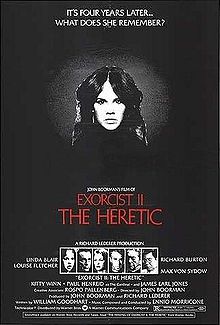
In truth EXORCIST II was initially conceived by Warner Bros. execs as just that. What resulted, however, was a costly epic with a downright horrific production history (Boorman was deathly ill for much of the filming). Furthermore, the finished film had little in common with THE EXORCIST, with its Catholic-tinged horror replaced by a weird African-based locust menace. The violence and unpleasantness were also dialed down considerably in a film that’s ultimately closer to visionary fantasy than pure horror. Again, though, that’s not to say it’s in any way a good movie!
Indeed, what’s truly fascinating about EXORCIST II is how uniformly lousy its every element is. That’s despite the fact that quite a few talented people worked on the film, starting with John Boorman (whose other films include classics like POINT BLANK, DELIVERANCE and EXCALIBUR). Didn’t he or anyone else notice that the desert set where much of action occurs (with a patently obvious painted sunset in seemingly every shot) is tacky in the extreme? That the extensive model work isn’t the slightest bit convincing? That the Ennio Morricone score sounds like the soundtrack of a bad 1970s-era porno? That the cinematography by the talented William A. Fraker is ugly (with a vomit-like yellow sheen) and rarely ever matches from one scene to the next? That co-star Louise Fletcher delivers essentially the same performance she did as the soulless Nurse Ratched (in ONE FLEW OVER THE CUCKOO’S NEST)? That Richard Burton in the lead role is even hammier than usual?
Unsurprisingly, EXORCIST II was a massive bomb, but it’s not entirely without interest. Martin Scorsese is an admitted fan, having stated that it “surpasses” THE EXORCIST, and that “Maybe Boorman failed to execute the material, but the movie still deserved better than it got.” I agree wholeheartedly with the second claim.
LEGION
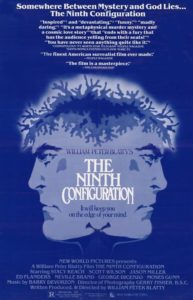 It seems nobody disliked EXORCIST II more than the original film’s makers, novelist/screenwriter William Peter Blatty and director William Friedkin (who calls it “The Hairy Tick”). Blatty was reportedly offered a lot of money to write a sequel to THE EXORCIST but turned down the offer. Years later he conceded that “I wish I’d done it now. Then at least we would never have had THE HERETIC…”
It seems nobody disliked EXORCIST II more than the original film’s makers, novelist/screenwriter William Peter Blatty and director William Friedkin (who calls it “The Hairy Tick”). Blatty was reportedly offered a lot of money to write a sequel to THE EXORCIST but turned down the offer. Years later he conceded that “I wish I’d done it now. Then at least we would never have had THE HERETIC…”
Blatty’s self-directed 1980 film THE NINTH CONFIGURATION was intended as a nominal sequel, with its schizophrenic astronaut protagonist supposedly the very one THE EXORCIST’S demonically possessed Regan predicted would “die up there.” Aside from that, however, THE NINTH CONFIGURATION has nothing to do with THE EXORCIST, having been adapted from Blatty’s 1978 publication of the same name, which was actually a redrafted version of his comedic 1966 novel TWINKLE, TWINKLE, “KILLER” KANE.
THE NINTH CONFIGURATION has nothing to do with THE EXORCIST…
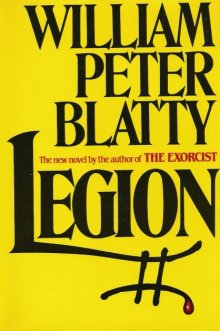 Yet Blatty did get around to writing a proper sequel: 1983’s LEGION apparently started life as a screenplay Blatty was unable to get filmed, so he wrote it as a novel. It focuses on the Georgetown based Lieutenant Kinderman, a close friend of THE EXORCIST’S Father Karras.
Yet Blatty did get around to writing a proper sequel: 1983’s LEGION apparently started life as a screenplay Blatty was unable to get filmed, so he wrote it as a novel. It focuses on the Georgetown based Lieutenant Kinderman, a close friend of THE EXORCIST’S Father Karras.
In LEGION, which picks up 12 years after the events of THE EXORCIST, Kinderman is back. He’s investigating a series of killings that parallel those of the long dead “Gemini” killer who terrorized San Francisco years earlier. The only thing is, the recent killings appear to have been committed by several different people, even though the murders all bear remarkably similar markings and patterns…almost as if the perpetrators were demonically possessed by the spirit of the Gemini killer. This all leads Kinderman to a mental patient locked up in a secluded wing of a local institution, and a supernatural confrontation twelve years in the making.
Most of the things that made THE EXORCIST (the novel) such a memorable read are in evidence in LEGION, including page-turning suspense, strong characterizations and a powerful sense of raging evil. That evil never quite erupts like it did in the earlier novel—LEGION being a far quieter, more restrained work overall–but is still very much a vivid and distinct presence throughout.
Most of the things that made THE EXORCIST (the novel) such a memorable read are in evidence in LEGION, including page-turning suspense, strong characterizations and a powerful sense of raging evil.
Where LEGION goes wrong, I feel, is in the theological arguments Kinderman is always having with himself and seemingly everyone with whom he comes into contact. These arguments stem from the age-old query of how can it be that a just and loving God allows so many terrible things to occur? Good question, but other than a rather trite theory that the figure of Lucifer the fallen angel actually represents us humans, this book doesn’t come close to answering it. Blatty was on a scientific/spiritual kick at the time; he apparently assumed his readers were all rabid atheists, and offers up many quasi-scientific arguments in support of the power of faith. These passages don’t dilute Blatty’s storytelling mastery, but they do add a lot of clutter to an otherwise impeccably told tale.
THE EXORCIST III
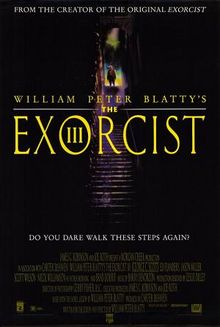 Blatty’s attempts at filming LEGION finally came to fruition in 1990, with the production of THE EXORCIST III, scripted and directed by Blatty (William Friedkin and John Carpenter had previously been attached as directors). The Morgan Creek Productions bankrolled film, unfortunately, is best known nowadays for its torturous postproduction. It’s become the horror equivalent of GREED or THE MAGNIFICENT AMBERSONS: a promising film severely compromised by extensive reshooting and editing, with Blatty’s original version said to be permanently lost.
Blatty’s attempts at filming LEGION finally came to fruition in 1990, with the production of THE EXORCIST III, scripted and directed by Blatty (William Friedkin and John Carpenter had previously been attached as directors). The Morgan Creek Productions bankrolled film, unfortunately, is best known nowadays for its torturous postproduction. It’s become the horror equivalent of GREED or THE MAGNIFICENT AMBERSONS: a promising film severely compromised by extensive reshooting and editing, with Blatty’s original version said to be permanently lost.
THE EXORCIST III’s early scenes nicely capture LEGION’S sense of muted menace. George C. Scott is memorable as Lt. Kinderman, and Blatty wisely leaves out the theological hectoring that marred the novel. The film adheres strongly to LEGION’S underlying narrative, and boasts a stark and unpretentious visual style. There are even some good scare sequences, notably a shock killing that takes place in a dark hallway.
THE EXORCIST III’s early scenes nicely capture LEGION’S sense of muted menace.
Where THE EXORCIST III really goes off the rails is in the outrageously wrongheaded third act, which is where the changes ordered by Morgan Creek honcho James Robinson (who owns the rights to the EXORCIST franchise) become apparent. Among other not-in-the-novel irritants, Kinderman’s daughter is nearly beheaded in a ridiculous scene, and a priest shows up at the psychiatric ward where the killer is sequestered to perform a perfunctory (and unnecessary) exorcism. This film had great promise that may have been fulfilled in Blatty’s original vision, but the chances of us ever seeing that vision are slim to none.
Where THE EXORCIST III really goes off the rails is in the outrageously wrongheaded third act, which is where the changes ordered by Morgan Creek honcho James Robinson (who owns the rights to the EXORCIST franchise) become apparent.
THE EXORCIST III wasn’t a huge success, and you’d think Warner Bros and Morgan Creek would know by this point to leave well enough alone. Surprisingly, they didn’t.
EXORCIST: THE BEGINNING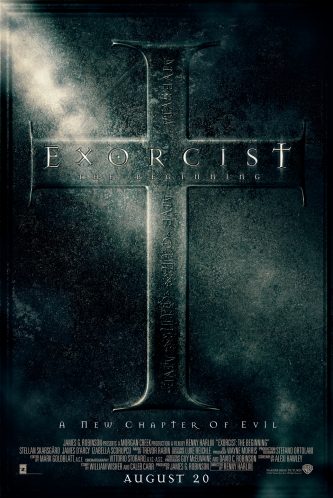
In the wake of the shockingly successful theatrical release of THE EXORCIST: THE VERSION YOU’VE NEVER SEEN in the fall of 2000, Morgan Creek greenlit an EXORCIST prequel. The director was John Frankenheimer, who died suddenly in July 2002, shortly before filming was set to commence. Paul Schrader was hired to replace him, but, in an apparent rehashing of THE EXORCIST III’s postproduction woes, was canned after the aforementioned James Robinson viewed Schrader’s rough cut in 2003.
Dismissing Schrader’s film as a “practice movie,” Robinson hired Renny Harlin to make an entirely new film incorporating Schrader’s footage. What resulted was 2004’s dreadful EXORCIST: THE BEGINNING.
Dismissing Schrader’s film as a “practice movie,” Robinson hired Renny Harlin to make an entirely new film incorporating Schrader’s footage. What resulted was 2004’s dreadful EXORCIST: THE BEGINNING.
Harlin’s prime directive with this film was apparently to spice up Paul Schrader’s resolutely non-exploitive film with excess gore and sensationalism, yet the resulting film is even more boring and uninvolving than Schrader’s (which I’ll get to next). It’s about the early days of Father Merrin (incarnated by Max von Sydow in the first EXORCIST and played here by Stellan Skarsgard), who finds himself excavating an ancient church somewhere in Africa. There are upside down crucifixions, gratuitous bloodletting and demonic possession (not to mention some really shitty CGI effects) a ‘plenty in this version, but it just never comes to life.
DOMINION: PREQUEL TO THE EXORCIST
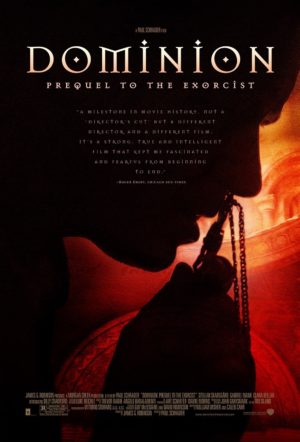 This brings us, finally, to DOMINION: PREQUEL TO THE EXORCIST, which Paul Schrader completed and Morgan Creek released in 2005. Taken together, EXORCIST: THE BEGINNING and DOMINION mark one of the oddest big studio releases of all time, being a single film that wound up as two, with the original version distributed after the reshot one.
This brings us, finally, to DOMINION: PREQUEL TO THE EXORCIST, which Paul Schrader completed and Morgan Creek released in 2005. Taken together, EXORCIST: THE BEGINNING and DOMINION mark one of the oddest big studio releases of all time, being a single film that wound up as two, with the original version distributed after the reshot one.
I REALLY wanted to like Schrader’s film, but it left me cold despite some good moments. Most of said moments occur near the end, when Stellan Skarsgard as the young Father Merrin stops schlepping around an African village (as he does for most of the movie) and gets down to confronting the forces of darkness in a surprisingly ethereal and poetic special effects packed showdown. In truth, DOMINION is far from the thoughtful horror fest it was advertised as, being a tortured rumination on faith and evil with all the charm of Ingmar Bergman on downers (the crowd I saw it with displayed their opinion by holding noisy belching contests throughout).
I REALLY wanted to like Schrader’s film, but it left me cold despite some good moments.
One thing I will say about DOMINION is that it actually replicates the overall mood and feel of William Peter Blatty’s LEGION better than THE EXORCIST III. This explains why Blatty likes DOMINION, having dubbed it “wonderfully acted and directed” and “a class act.”
And here the saga finally ends—or does it? Believe it or not, there is apparently more EXORCIST-related media on the horizon, with Robinson promising an EXORCIST TV series. Be afraid, be very afraid!
